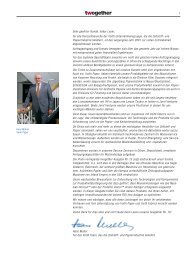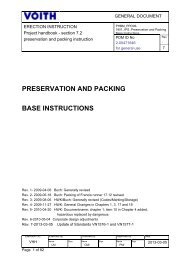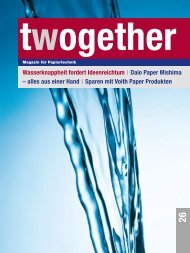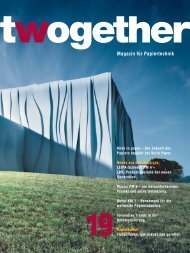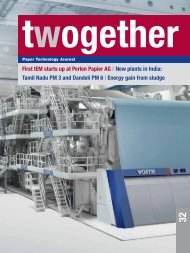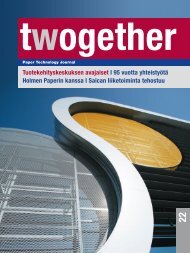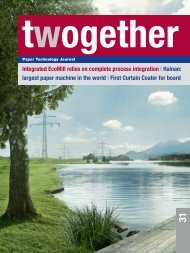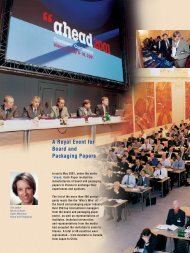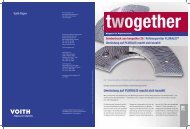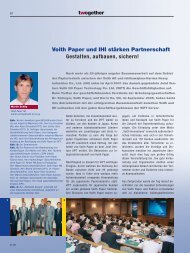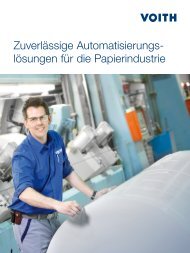Create successful ePaper yourself
Turn your PDF publications into a flip-book with our unique Google optimized e-Paper software.
8<br />
Fig. 1: Previous AK design.<br />
Fig. 2: New CompactPulper design.<br />
Fig. 3: 3D presentation of the new Compact-<br />
Pulper.<br />
Fig. 4: Chest widths: comparison between<br />
conventional and new design.<br />
At sheet breaks the broke pulper must<br />
reach full operating speed from start-up<br />
in the shortest possible time. The procedure<br />
is as follows:<br />
As soon as a sheet break is detected, the<br />
sheet is diverted directly into the broke<br />
pulper located ahead of the sheet break.<br />
At the same time the showers open, and<br />
the sheet is wetted and pulled down with<br />
the water flow. In the meantime, the<br />
pulper rotors have reached full speed,<br />
generating enough circulation energy to<br />
draw in the sheet, which is then rapidly<br />
pulped down and pumped off through the<br />
pulper screenplate.<br />
Based on <strong>Voith</strong>’s long experience, with<br />
over 375 AK series pulpers delivered<br />
since 1990, the objective of this development<br />
project was to further increase<br />
broke pulper efficiency whilst at the same<br />
time reducing investment costs.<br />
Slushing conditions in the broke pulper<br />
1 2<br />
<strong>17</strong>/04<br />
seem simple at first sight, but a closer<br />
look quickly reveals just how many<br />
boundary conditions have to be simultaneously<br />
taken into account in order to ensure<br />
reliable operation:<br />
● <strong>Paper</strong> machine width and speed<br />
● <strong>Paper</strong> grade, basis weight and location<br />
of the sheet break in the machine<br />
● Pulping intensity and suspension level<br />
● Dwelltime<br />
● Broke removal rate through the pulper<br />
screenplate.<br />
Additionally, the pulping consistency has<br />
to keep within certain limits to ensure a<br />
reliable sheet draw-in, good pulping and<br />
stable pump operation.<br />
The development project was carried out<br />
on two levels due to the complexity of the<br />
process and also the need for field trials:<br />
● A full-size trial pulper, incorporating<br />
the new optimized geometry of the<br />
CompactPulper, was tested in <strong>Voith</strong><br />
<strong>Paper</strong>’s <strong>Technology</strong> Center. This<br />
enabled intensive investigation of<br />
machine parameters which usually<br />
cannot be changed in mill operation<br />
● Extensive mill trials and comparison<br />
with the <strong>Technology</strong> Center’s trial<br />
results.<br />
Figs. 1 and 2 show the differences<br />
between the conventional broke pulper<br />
design and the new CompactPulper.<br />
The trials clearly showed that a large part<br />
of broke pulping energy is used for moving<br />
the stock round. Compared with<br />
pulpers for slushing recovered paper or<br />
virgin fiber pulp, in broke pulpers the<br />
sheet is brought into the pulper in a<br />
clearly defined way. It has already been<br />
thoroughly wetted on both sides by the<br />
showers. This means that pulper dwelltime<br />
is reduced by the time otherwise required<br />
for breaking down and wetting the<br />
paper when presented in bale form.The<br />
pulper chest can therefore be much<br />
smaller, as confirmed by the trial results.



